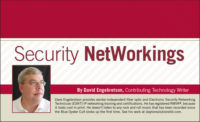
When surveying a potential installation, some security dealers/integrators seem to shy away from using fiber optics. When asked why, many state that fiber is too tricky to work with and that their technicians have neither the training nor the correct tools and testers to authoritatively handle fiber connections.
Smart installation companies also are concerned with what happens after the job is completed. How will they troubleshoot and fix balky equipment that is connected to fiber links? Although these concerns are valid, physical security companies who don’t do fiber optics are missing a rich vein of opportunity.
Fiber is superior to copper cabling in every performance parameter. The available bandwidth of standard multimode fiber is 45 times that of Cat 5e UTP. Scores of surveillance cameras can transmit their signals over one or two fiber strands.
EMI and RFI interference is vanquished because the signals traveling through a fiber are optical, generated by either a blinking LED or laser. Fiber can be installed in the worst electrical interference environments possible with absolutely no detrimental effects.
Fiber also provides great potential cabling distances. Inexpensive fiber devices can easily traverse up to two miles from end to end on multimode fiber, while high-bandwidth single-mode fiber can carry signals up to 60 miles before regeneration of the signal is necessary.
The real gold mines for security installation companies are unused fiber links that are already in place.
The cabling industry estimates that more than 80 million “dark” fibers are installed in North America. These unused fibers are the result of the very low cost of individual fiber strands and the prevailing philosophy in the cabling industry, which is to always include extra fiber strands when installing structured cabling backbone cables between telecommunications closets and separate buildings.
Many of your commercial clients have existing fiber links that they are not using right now. Astute security companies always ask clients whether any fibers are available that can be used for an impending physical security installation.
If they are available and the client allows their use, the security contractor can connect a multitude of devices and transmit their images or signals to wherever the fibers are terminated. Long cable pulls can be eliminated or greatly reduced and transmitted signals will be completely free of EMI/RFI interference.
Physical security companies who are ready and able to work with fiber have a tremendous advantage over those who don’t because they can effectively utilize the plethora of dark fiber extant in pre-installed structured cabling systems.
I’ve been preaching this gospel for the last 10 years with decidedly mixed results. Many security dealers hesitate to use fiber not just because of their unfamiliarity with fiber installation, testing and terminations, but because of the high cost of analog/electrical to fiber converters that are needed to, for example, connect four analog cameras to a fiber link. What changes this equation is the explosion of IP cameras, access control and intercom devices now available.
Consider a situation where an installation needs four cameras connected to existing multimode fiber links between buildings. If using IP cameras, the fiber link can be connected using low-cost Ethernet to fiber converters for about $125 for each end. Plug in an inexpensive Unicomm or Netgear switch, and the IP cameras are up, running and available to any authorized users on the LAN or perhaps the Internet.
Security installation companies need to man up and invest in training and proper tools so they can effectively handle fiber installations and troubleshooting. Where to start? For general knowledge, a wealth of articles are available atwww.sdmmag.com, including such titles as “Testers and Their Uses.” Just search under “fiber.”
For specific detailed knowledge, check out my online course atwww.FiberOpticsInstitute.com.
For hands-on training and Fiber Optic Association certification, we will be offering regional, one-day fiber optic “Certification Labs” at various ADI locations in 2008.
Wherever your company’s technicians obtains their knowledge, a working knowledge of fiber is now critical for upscale physical security companies. The time is now.
Book of the Month
Fiber Optics Technician's Manual, Third Editionby Brian Contos, Syngress
Gain a good knowledge of fiber by reading this book by fiber guru Jim Hayes. An excellent training manual and resource, the manual is available atamazon.comand book stores.




